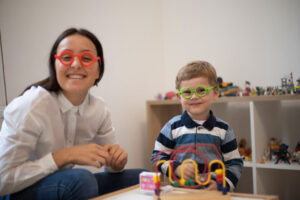How to Become a Child Behavioral Therapist: Pediatric Behavioral Therapy Explained
 Autism Spectrum Disorder (ASD) diagnoses boomed in the United States in the late nineties. The prevalence of ASD in 2016 was 1 in every 54 children according to the Centers for Disease Control in 2020… a 10 percent jump from 2014.
Autism Spectrum Disorder (ASD) diagnoses boomed in the United States in the late nineties. The prevalence of ASD in 2016 was 1 in every 54 children according to the Centers for Disease Control in 2020… a 10 percent jump from 2014.
So many kids and parents need professional help with ASD and other developmental and behavioral issues that how to become a child behavioral therapist has become a big question for thousands of individuals who want to help.
To become one of them, you will need to become certified as a BCBA (Board Certified Behavior Analyst) by the Behavior Analyst Certification Board (BACB). It’s a demanding path with a rewarding destination.
Behavioral Therapy for Kids is The Most Rewarding Area of ABA Practice
There, we said it.
ABAs who work with kids have the most fun, make the biggest difference, and get the most satisfaction out of their jobs.
 ASD isn’t the only kind of issue you will face as a child behavioral therapist. There are many developmental issues that ABA-trained therapists can help parents and schools with, from ADHD (Attention-Deficit Hyperactivity Disorder) to bedwetting.
ASD isn’t the only kind of issue you will face as a child behavioral therapist. There are many developmental issues that ABA-trained therapists can help parents and schools with, from ADHD (Attention-Deficit Hyperactivity Disorder) to bedwetting.
If you love working with kids, then even the most challenging problems you face in the day will come with the joy and energy of making those little faces light up.
How long does it take to become a child therapist?
From the point you graduate from high school, you can expect to spend at least seven years preparing to become a child behavioral therapist. With accelerated studies and intensive options available for getting the required field experience, it may be possible to shave a year or two off the total timeline.
Step 1. Earn an Undergraduate Degree in a Related Field
Step 2. Get a Master’s-level Child Behavioral Therapist Degree
Step 3. Earn Experience in Pediatric Behavioral Therapy
Step 4. Become a Board Certified Behavior Analyst and Get Licensed in Your State
Step 5. Get a Job And Start Pulling Down a Child Behavioral Therapist Salary
Step 1. Earn an Undergraduate Degree in a Related Field
You’ll eventually need to earn a master’s degree, so getting a bachelor’s degree is your first step on this path. You have a lot of different options if you want to specialize in child behavioral therapy.
A degree in psychology or applied behavioral analysis are never bad choices to prepare for advanced studies in ABA. But since you are planning to work with children, you can also consider bachelor’s degrees in education or early childhood education. Any program that offers training in lifecycle development or offers direct interaction with kids is a solid choice.
Step 2. Get a Master’s-level Child Behavioral Therapist Degree
 To get the kind of expertise you will need to handle any kind of child behavioral problem that comes your way, you will need to go on to earn a two-year master’s degree. You can also go full-bore and get a doctorate to qualify, but let’s not get ahead of ourselves. A master’s is tough enough!
To get the kind of expertise you will need to handle any kind of child behavioral problem that comes your way, you will need to go on to earn a two-year master’s degree. You can also go full-bore and get a doctorate to qualify, but let’s not get ahead of ourselves. A master’s is tough enough!
Your choices at this level become a little narrower.
In order to qualify for certification as a child behavioral therapist, you’ll need to pick a degree in psychology, applied behavior analysis, or education.
The program you choose will also have to include the Verified Course Sequence (VCS) outlined by ABAI (Association for Behavior Analysis International).
In addition to being a requirement of certification, the VCS gives you important coursework you’ll use in child behavioral therapy, including:
- Behavioral measurement and assessment skills
- Basic principles of applied behavioral analysis
- Behavioral intervention strategies and techniques
- Professional ethics training
VCS-recognized programs also include field experience as a part of the training, so you get a chance to practice all the skills you are learning in the classroom.
It’s also a good idea to look for a program that offers a concentration in special education or in child development. These programs will give you a more direct education in the particular issues encountered by child behavioral therapists.
Start your journey to becoming a child behavioral therapist by finding an ABA master’s program.
Step 3. Earn Experience in Pediatric Behavioral Therapy
No one is going to turn you loose in the classroom with just a degree, even if it’s a master’s. Another big part of becoming certified in child behavioral therapy is getting real-world experience in analyzing and treating kids.
Although you will have gotten some exposure to this as a part of your degree, which will have included practicum or internship placements in actual clinics or schools, this next step delivers a far more lasting and intensive experience. You’ll spend up to a year under the careful supervision of experience behavioral therapists handling a variety of real patients. You’ll use your own knowledge and expertise to assess kids, design treatment plans, and put interventions to work.
The BACB accepts three different types of experience, each with different contact and supervision requirements:
- Supervised experience – You’ll need 1500 hours, including at least two contacts per month with your supervisor
- Practicum – 1000 hours of practicum are accepted, with a more rigorous four supervisory contacts per month
- Intensive practicum – Only 750 hours are needed, but you’ll have to keep up eight supervisor contacts per month
Step 4. Become a Board Certified Behavior Analyst and Get Licensed in Your State
 BACB certification is a must-have for performing applied behavior analysis with kids. First, it’s a requirement for most employers that might hire you and for many insurance companies in order to bill for your services. Second, of the 33 states that require licensure for practicing as a behavioral therapist, many of them either directly accept the BCBA as a qualification, or mirror the requirements you need to fill for that credential anyway.
BACB certification is a must-have for performing applied behavior analysis with kids. First, it’s a requirement for most employers that might hire you and for many insurance companies in order to bill for your services. Second, of the 33 states that require licensure for practicing as a behavioral therapist, many of them either directly accept the BCBA as a qualification, or mirror the requirements you need to fill for that credential anyway.
You’ve been working toward that BCBA ever since step 2, since a master’s degree with a Verified Course Sequence is an important part of the process. So was that year of supervised experience or practicum that you put in on step 3.
Your final step to that coveted BCBA is to take and pass the BACB exam. At 160 questions, all multiple choice, it’s a comprehensive dive into your client-centered responsibilities and basic behavior analysis knowledge and tasks. You’ll need to bone up to have a good chance of passing it on the first try and making sure your $245 application fee doesn’t go to waste.
Each state that licenses behavior analysts has their own system, costs, and requirements for doing so. You’ll need to check with your state licensing board. Typically, you’ll submit the same proof of schooling and experience as you did for the BCBA, or just the proof of your BCBA itself. Some states have background check requirements or jurisprudence tests on local laws covering therapy services.
What qualifications do you need to be a child therapist?
There are no special qualifications to become a child behavioral therapist beyond the usual certification and licensing needed to become an applied behavioral therapist.
That means you follow the standard process for becoming a BCBA and getting licensed to practice as an ABA in your state, if your state is one of those with ABA licensing requirements.
If you are in private practice, you’ll also need a business license to be a child therapist. If you decide to apply with a school district or larger behavioral therapy clinic, they may require additional experience working specifically with children.
Step 5. Get a Job And Start Pulling Down a Child Behavioral Therapist Salary
Working with children is probably the role that applied behavior analysts are best known for, so it’s not hard to find jobs in child behavioral therapy. According to the BACB, almost three quarters of all BCBAs work in the field of autism spectrum disorder, an area of practice heavily weighted toward children. Another eleven percent work in the education industry more generally.
You can find child behavioral therapy positions directly with school districts almost anywhere in the nation. Those roles are crucial in special education and even just in helping with general classroom management, so they aren’t going away anytime soon.
There are also many, many private practices for child behavioral therapy specialists. Clinics that work directly with autistic kids and their families are a booming business, and constantly hiring. Or you have the option of starting up your own practice and working independently.
In some cases, you can combine both worlds, finding lucrative contracts through private practices that are hired to provide behavioral therapists for schools.
In any case, job security is solid for child behavioral therapists, and so are pay rates!
How much do child behaviorists make?
The professional category that the Bureau of Labor Statistics (BLS) places child behavioral therapists into showed an average median salary of $48,520 as of 2021. BLS doesn’t break out the specific salary figures for ABA therapists in general, much less child behavioral therapists specifically, but school psychologists, a related group, make $78,200 per year. It’s reasonable to expect that positions in public schools pay somewhere between those two figures.
2021 US Bureau of Labor Statistics salary and employment figures for [Substance Abuse, Behavioral Disorder, and Mental Health Counselors, Clinical, Counseling, and School Psychologists] reflect national data, not school-specific information. Conditions in your area may vary. Data accessed December 2022.





